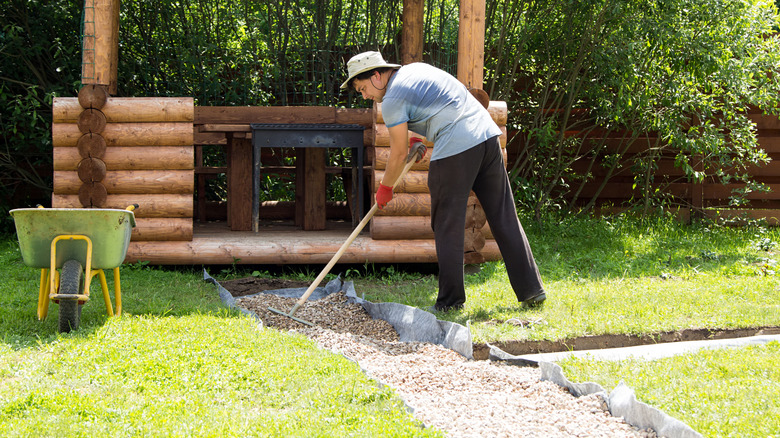A Popular Decorative Yard Feature May Accidentally Lower Your Home Value
There are loads of ways you can use gravel in your yard, from creating a low-maintenance patio to filling in gaps between paver stones. However, this popular, affordable option can accidentally lower your home's value when proper maintenance is neglected. That's because gravel is permeable and allows moisture to enter exposed soil, thus creating a cozy, damp environment where weeds can thrive.
What's more, the spaces and cracks between the gravel rocks also let in various organic matter and debris, which can provide nutrients and further fuel weed growth. These problems are compounded further when the gravel is placed in areas with heavy foot or vehicle traffic. Constantly pressing down on the gravel compacts it and that, in turn, limits drainage and traps water, allowing weeds to thrive.
Once these unwanted plants set down roots, they can quickly spread and infiltrate the entire gravel-covered area, turning your yard into an eyesore. Indeed, this simple landscaping mistake can both age your house and lower its value. One option is to remove and replace the gravel altogether; however, if you'd prefer to keep it for practical or aesthetic reasons, there are a few simple steps you can take to keep your gravel-covered yard weed-free.
How to banish weeds from a gravel-covered yard
The key to banishing weeds from a gravel-covered yard is two-fold and involves both removal and prevention. If weeds have already begun to sprout up between the stones, start by removing all of them, ensuring not to leave any living roots behind. This can be done by either manually pulling up the weeds, using a top-quality herbicide, or covering them with rock salt.
Once any existing weeds are eliminated, it's time to focus on stopping them from ever returning. Because weeds love moisture and gravel tends to keep water locked in, adding drainage channels or creating a runoff slope can help. Another option is to install a layer of landscaping fabric underneath the gravel to keep weeds from setting down roots. Swapping in larger stones to minimize gaps and spaces can also make a big difference.
However, one of the simplest but most often overlooked solutions for preventing weeds in gravel is raking. By regularly raking your yard and shifting the stones around, you will simultaneously remove nutrient-rich organic matter, pull up any potential weed seedlings, and keep the gravel from thinning out. The latter is important because when the layer of gravel becomes too thin (less than 2 inches thick), it allows sun to permeate the soil, thus spawning weed growth.

